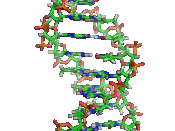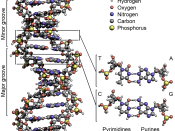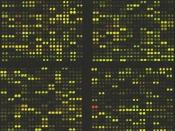The genetic material that makes up a persons inherited features (sex, eye color and blood type) is called DNA. (Deoxyribonucleic Acid) DNA is a long molecule that is made up of building blocks called nucleotides. What order the nucleotides are in is extremely important. Grouped together the nucleotides form genes. Every persons DNA contains over 40,000 genes. Each inherited feature is determined by one or more gene. The order of the nucleotides in the DNA is unique in every person.
DNA makes up the thin strands (chromosomes) found in the center (nucleus) of all body cells. The only exceptions are red blood cells and platelets. DNA finger printing can be done with a sample from any tissue in the body. DNA is obtained from white blood cells. A drop of blood or a air bulb contains enough DNA for testing. The is no special preparations for this test.
To obtain a DNA fingerprint, cells containing DNA are collected and purified, The cells are broken open and their DNA is separated, if only a small amount of DNA is available it may be duplicated by a process called amplification. The DNA is treated with proteins (called restriction enzymes) that cut it at specific locations to provide DNA fragments of different lengths, since each persons DNA sequence is unique the pattern of DNA varies among every individual. Using an electrical current DNA splices are separated according to size on a thin slab of material similar to gelatin. The DNA on the gel is transferred to a nylon membrane because it is more sturdy than the gel. The nylon membrane is soaked with solution containing radioactive chemicals called probes that specifically bind to certain types of DNA fragments. The probes will only bind to a few (up to 20) of...



DNA
Nice compilation of information, was very useful. Thanks!
0 out of 0 people found this comment useful.